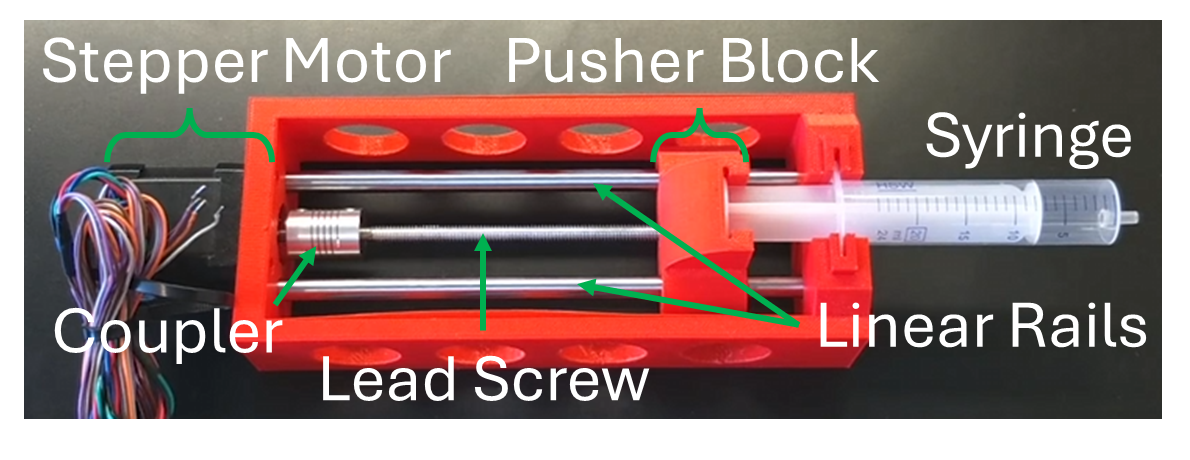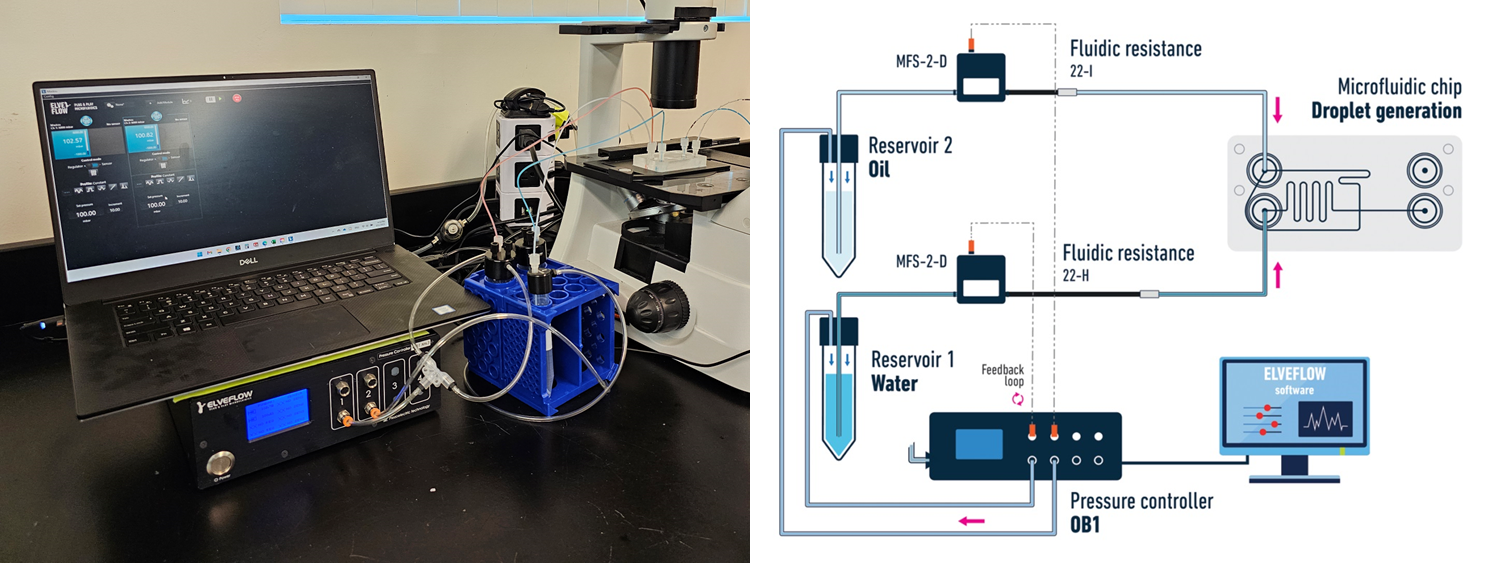Common Flow Control for Microfluidics: In the lab
Published by Alex Hwu & Ehsan Shamloo on Mar 12th 2025
Microfluidic applications are becoming a standard tool in today's research lab and commercial products. From precision dispensing, lab-on-a-chip, point-of-care diagnostics, and many more, microfluidic technologies rely on accurate and consistent manipulation of very small amounts of fluid ranging in volume from microliters down to a few picoliters. This post provides a quick overview of three equipment commonly used for controlling flow in microfluidic systems so users can be up and running with the fluidic experiments.
Too long, didn't read summary:
- Try a syringe pump first by borrowing from a neighboring lab or by buying a low-cost New Era. Expect fluctuations up to 10%.
- If the flow fluctuations causes too much experimental variability, one of two options depending on flow rate requirements:
- Flow rates <0.1 µL/min, use a syringe pump ($6k) and low friction glass or stainless-steel syringes (~100-200$).
- Flow rates >0.1 µL/min, get an Elveflow OB1, or other pressure controller ($6k for single channel with pressure generator).
- Peristaltic pumps have niche applications:
- Using waterproof-rated peristaltic pump in an incubator to generate recirculating flow for organ-on-a-chip.
- General flow applications like tangential flow filtration cassettes.
Syringe Pump
Syringe pumps are the go-to choice when first evaluating microfluidic flow controllers for an experimental setup. A stepper motor pushes (infuse) or pulls (withdraw) the syringe plunger at a controlled rate to manipulate the fluid in a microfluidic channel. Figure 1 shows the mechanical components of a simple, DIY syringe pump with a 3D printed frame and pusher block. Syringe pumps are relatively easy to set up Due to the accuracy, industrial syringe pumps are often integrated into high-precision dispensers and analytical instruments. Flow rate fluctuations are expected (+/-10%) for laboratory syringe pumps and will depend on the manufacturer and syringe type (plastic vs glass vs stainless steel). 
Figure 1. Mechanical components of a DIY syringe pump with a 3D printed frame and pusher block.¹
Main Points:
- Quickest option when evaluating flow control for microfluidic applications.
- Flow is based on the inner diameter of the syringe and linear displacement rate of the plunger.
- High accuracy for wide range of flow rates but expect fluctuations up to 10% depending on manufacturer.
- Good for constant flow or volume dispensing.
- No plug & play option for automation integration except for specialty products like the SPC Modular Syringe Pump capable of sequential injection.
Technical Considerations:
- Slow response time. Changing the flow rate set point does not result in immediate flow rate changes.
- Overpressure can result in inaccurate flow rates in high-resistance fluidic setups.
- Connecting multiple syringe pumps to one microfluidic chip (droplet generation) requires optimization.
- Microstepping generates unstable flow, especially when using a plastic syringe.
- Tradeoffs between syringe size, flow rate stability, and experiment duration.
Pneumatic (Pressure) Controllers
Pneumatic controllers, like the OB1 by Elveflow, are a versatile solution for any microfluidics lab. A pressure differential is generated between a liquid reservoir (inlet) and the chip outlet to drive fluid flow. Additionally, pressure controllers can be leveraged to actuate on-chip valves or on-chip pumps (not discussed here). The rapid response time and short settling time allows users to test dynamic flow conditions in real time without needing to reset the system. Figure 2 below shows an example setup and schematic for generating microfluidic droplets using a two-channel pressure controller with flow sensors.

Figure 2. Example setup of droplet generator setup without flow sensors (left) and schematic of droplet generator setup with flow sensors (right)².
Main Points:
- Best option for users wanting to test dynamic or multiple flow rates in their fluidic setup.
- Flow is based on pressure differential between inlet and outlet.
- Capable of dynamic flow rates ranging from 0.1 µL/min to 500 mL/min.*
- Plug & play solution with accessories, like in-line flow rate sensors, suitable for additional fluid control features.
- Compatible with reservoirs up to 100 mL.
*Accuracy and precision depends on controller's pressure range.
Technical Considerations:
- Learning curve and pricing may appear intimidating.
- Expansive potential with continuous hands-on experience and add-on accessories.
- Requires external pressure and/or vacuum and additional accessories like reservoir caps for operation.
- Popular applications using additional accessories include:
- Automated sequential injection
- Lipid nanoparticle synthesis
- Droplet generation
- Spatial transcriptomics
Peristaltic Pump
Peristaltic pumps are less common for microfluidic flow control due to the pulsatile flow characteristic. The rotating rollers compress the flexible tubing, pushing liquid in a plug-like fashion (Figure 3 below). Peristaltic pumps are more commonly used for transferring or dispensing set volumes of liquids rather than for precise flow rate control. Common uses in microfluidic applications include generating constant liquid flow through a microchannel like for multiplexed assays or continuous recirculating flow in a closed loop microfluidic system.  Figure 3. A waterproof-rated peristaltic pump (left) and conceptual illustration of rollers compressing soft-wall tubing to generate flow (right; Original by Ching et al. used under CC by 4.0 / Modified from original)³.
Figure 3. A waterproof-rated peristaltic pump (left) and conceptual illustration of rollers compressing soft-wall tubing to generate flow (right; Original by Ching et al. used under CC by 4.0 / Modified from original)³.
Main Points:
- Flow is based on roller rotation rate and the soft-wall tubing diameter.
- Lowest reliable flow rate in the 10-100 microliter range.
- Tubing degrades and needs to be replaced over time.
- Generates a pulsatile flow profile.
- Not as accurate or precise as syringe pumps or pressure controllers.
- Good for niche applications like recirculating flow in an incubator for organ-chip experiments using waterproof rated pumps.
Technical Considerations:
- Pulsatile flow profile can be minimized by using dampeners or by using asynchronous peristaltic pumps.
- Some pump heads require adjustment to tune the amount of tubing compression.
- Generates noise and vibrations.
- Requires some hands-on set up to get the right flow rates.
Conclusion
Setting up flow control for microfluidic experiments does not need to be intimidating. If you're still thinking about what best suits your needs, here's the summarized points:
Syringe pumps: Good for steady constant flow through a single channel. Exercise caution when using extremely low flow rates with plastic syringes and expect fluctuations. Higher end models and precision syringes (glass or stainless steel) needed for low nanoliter to picoliter range flow rates.
Pneumatic controllers: Best for advanced and dynamic flow control requirements. Pricing and learning curve can be intimidating but pressure controllers are a versatile equipment for any lab working with flow rates above 0.1 µL/min. Expansive fluid handling potential with plug-and-play add-on accessories.
Peristaltic pumps: Less common in microfluidic applications due to pulsatile flow profile which may not be suitable for all applications. Niche uses for specific pump models like using waterproof-rated pumps inside an incubator for continuous organ-on-a-chip recirculating flow. Requires some hands-on setup to calibrate performance for pump heads with a multi-channel cartridge design.
References
- UNC Greensboro Dept. of Chemistry & Biochemistry. “Flow Chemistry: Syringe Pump Assembly Video (Part 2).” YouTube, 13 June 2018, www.youtube.com/watch?v=dz2N6qxstk4. Accessed 12 Mar. 2025.
- “Easy Droplet Generation.” Elveflow, 30 July 2024, www.elveflow.com/microfluidics-application-packs/easy-droplet-generation/. Accessed 12 Mar. 2025.
- Ching, Terry, et al. “Highly-Customizable 3D-Printed Peristaltic Pump Kit.” HardwareX, vol. 10, Oct. 2021, p. e00202, https://doi.org/10.1016/j.ohx.2021.e00202.

